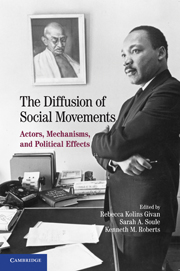Book contents
- Frontmatter
- Contents
- List of Tables
- List of Figures
- Contributors
- Preface and Acknowledgments
- 1 Introduction: The Dimensions of Diffusion
- PART I DIFFUSION AND THE FRAMING OF CONTENTIOUS POLITICS
- 2 Transnational Networks and Institutions: How Diffusion Shaped the Politicization of Sexual Harassment in Europe
- 3 Temporality and Frame Diffusion: The Case of the Creationist/Intelligent Design and Evolutionist Movements from 1925 to 2005
- 4 Framing Labor's New Human Rights Movement
- 5 Framing the GMO: Epistemic Brokers, Authoritative Knowledge, and Diffusion of Opposition to Biotechnology
- PART II MECHANISMS OF DIFFUSION
- PART III DIFFUSION, SCALE SHIFT, AND ORGANIZATIONAL CHANGE
- General Bibliography
- Index
4 - Framing Labor's New Human Rights Movement
Published online by Cambridge University Press: 05 June 2012
- Frontmatter
- Contents
- List of Tables
- List of Figures
- Contributors
- Preface and Acknowledgments
- 1 Introduction: The Dimensions of Diffusion
- PART I DIFFUSION AND THE FRAMING OF CONTENTIOUS POLITICS
- 2 Transnational Networks and Institutions: How Diffusion Shaped the Politicization of Sexual Harassment in Europe
- 3 Temporality and Frame Diffusion: The Case of the Creationist/Intelligent Design and Evolutionist Movements from 1925 to 2005
- 4 Framing Labor's New Human Rights Movement
- 5 Framing the GMO: Epistemic Brokers, Authoritative Knowledge, and Diffusion of Opposition to Biotechnology
- PART II MECHANISMS OF DIFFUSION
- PART III DIFFUSION, SCALE SHIFT, AND ORGANIZATIONAL CHANGE
- General Bibliography
- Index
Summary
INTRODUCTION
Framing strategies have always been central to advancing working class interests in an often unfavorable economic and political climate. The threshold reaction to collective struggles by workers is skeptical at best, and often hostile, in a society that celebrates individualism, control of private property, and entrepreneurial success. The fact that workers' methods of mobilization involve disruptive tactics such as protests, strikes, picketing, and boycotts only amplifies knee-jerk antipathy toward organized labor in the United States, even though these are time-honored methods of contestation in a democracy.
How workers and their unions define terms, present arguments, tell stories, amplify resonance, and evoke responses is critical to the outcomes of their struggles in the workplace and in society. The trade union movement has always needed middle-class reformist, professional, and intellectual allies to make organizing and collective bargaining gains and to win legislation favorable to workers. This chapter examines how workers have framed their appeals to potential allies in the past decade using new human rights arguments alongside more traditional economic justice arguments, and how changing discourse affects prospects for success or failure in such alliances. In particular, it looks at framing strategies in labor's efforts to win labor law reform after Barack Obama became president of the United States in 2009.
- Type
- Chapter
- Information
- The Diffusion of Social MovementsActors, Mechanisms, and Political Effects, pp. 56 - 77Publisher: Cambridge University PressPrint publication year: 2010



